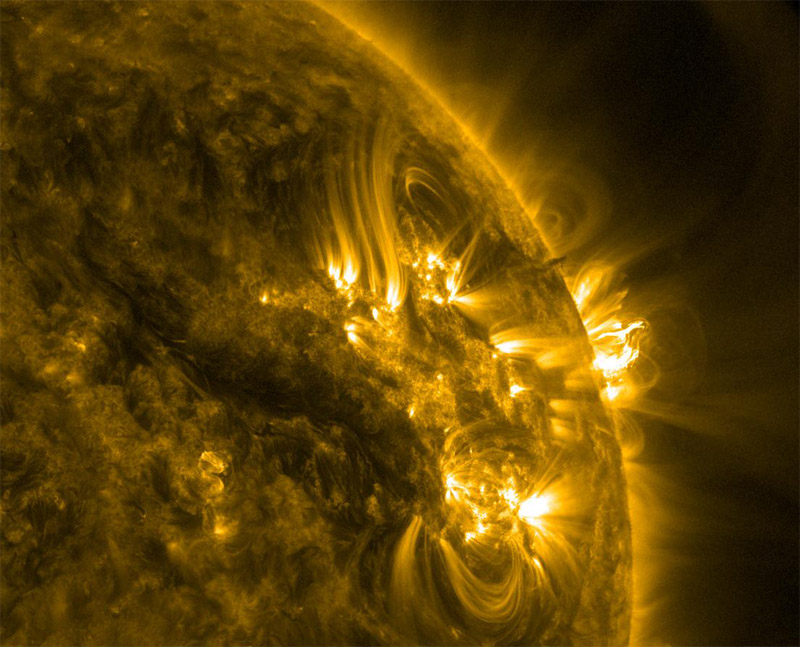
Sun Drags Space Junk Out of Earth Orbit
Ian O’Neill
Generally, solar flares are bad news for stuff orbiting the Earth. The impact of intense solar radiation on sensitive electronics can render the most sophisticated space technologies useless. Also, heating and expansion of the Earth’s upper atmosphere by peaking solar activity can increase drag on satellites, slowing them down, causing them to drop from orbit.
How could this negative situation be turned into a positive? What’s bad for operational satellites has the wonderful side effect of helping mankind with an increasingly pressing problem: the specter of space junk.
Ever since mankind launched the first rocket into space, we’ve left trash floating aimlessly in low-Earth orbit. Today, 55 years after the launch of the Soviet Sputnik 1 (the worlds first artificial satellite), we are fast approaching an untenable situation.
The space junk problem is reaching epidemic proportions where it may soon become impossible to launch spacecraft without them being damaged or destroyed by an errant chunk of Space Age trash — a situation known as “Kessler Syndrome.” You can forget a manned mission to Mars, we won’t be able to leave our own cosmic backyard through fear of being punctured by a random bolt traveling faster than a rifle bullet!

But according to a report (PDF) released by the NASA Orbital Debris Program Office this week, help may be at hand.
“Although high levels of solar activity are a bane to spacecraft operators, the consequent increase in the density of the Earth’s atmosphere is a welcome, albeit brief, respite from an otherwise growing orbital debris population,” says Nicholas Johnson, NASA Chief Scientist for Orbital Debris.
Say what? Solar activity might be able to help alleviate the space debris issue?
Yes, this is true; the same thing that threatens the safety of multi-million dollar satellite systems may be helping to “scrub” space trash from orbit. During periods of increased solar activity — like now — the sun turns into a passive vacuum cleaner of sorts.
As magnetic activity inside the sun amps-up toward peak activity in its 11-year solar cycle (known as solar maximum, predicted to occur in 2013), there is a higher frequency of solar flares and coronal mass ejections (CMEs). This increased energy output energizes the outer layers of the Earth’s atmosphere, and through the laws of basic thermodynamics, it causes the atmosphere to expand.
This expansion pushes some of the gas to higher altitudes. It’s like a speeding car hitting a sand-filled escape lane — the drag of the loose sand zaps the forward momentum of the car, bringing it to a stop. Back in orbit, this tenuous gas creates drag on orbiting space debris, causing it to slow down.
(Spacecraft sent to other planets — such as the Mars satellites — use this high altitude atmospheric drag to slow them down just before orbital insertion, a maneuver called “aerobreaking.”)
As the debris slows, Earth’s gravity pulls it to lower altitudes where the atmosphere is even thicker. Thicker atmosphere = more drag = slower debris. Eventually the debris reenters the atmosphere sooner than it would do without the solar influence, burning up safely (for the most part).
“The number of cataloged debris in Earth orbit actually decreased during 2011 as solar activity increased toward an anticipated maximum in 2013,” adds Johnson. “Smaller, uncataloged debris are even more affected by the changing atmosphere, causing even greater of their numbers to fall back to Earth.”
The dangers of space junk have been highlighted in recent years, most notably by the “ill-advised,” as Johnson puts it (or “irresponsible,” as I’d put it), Chinese Fengyun-1C anti-satellite test in January 2007.
Of the 3,218 cataloged debris from the Fengyun-1C destruction, only 6 percent of the pieces have reentered the atmosphere. But half of those pieces came down in the last 12 months, highlighting the part increased solar activity had to play in removing the debris from orbit.
Although the sun is helping out, it isn’t going to last forever. After 2013, the sun will start to quieten as magnetic activity becomes subdued as it approaches “solar minimum.” It will be up to us to be more responsible, preventing the littering of Earth orbit through tighter launch regulations and hoping China — or any other nation for that matter — doesn’t take another potshot at a satellite.
